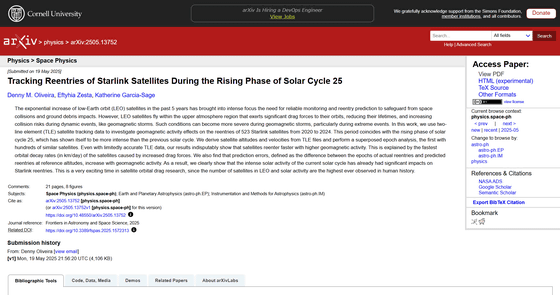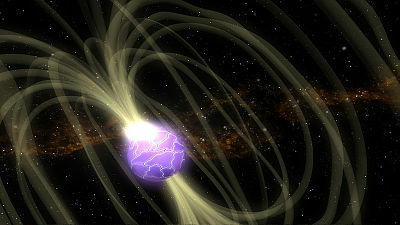It turns out the sun is shortening the lifespan of SpaceX's Starlink satellites

SpaceX's satellite internet network, Starlink, is realized by a large-scale
[2505.13752] Tracking Reentries of Starlink Satellites During the Rising Phase of Solar Cycle 25
https://arxiv.org/abs/2505.13752

The sun is killing off SpaceX's Starlink satellites | New Scientist
https://www.newscientist.com/article/2481905-the-sun-is-killing-off-spacexs-starlink-satellites/
According to the research team, the number of LEO satellites has increased exponentially over the past five years, increasing the need for reliable monitoring and re-entry prediction to prevent collisions in space and debris falling to the ground. Because LEO satellites fly in the upper atmosphere, they are subject to significant drag, which results in a shortened satellite lifespan.
In addition, the lifespan of satellites in Earth orbit, especially large satellite constellations such as SpaceX's Starlink, is greatly affected by solar activity. In particular, if solar activity causes large-scale geomagnetic activity such as geomagnetic storms , the risk of satellite collisions increases.
The study investigated the effect of geomagnetic activity on satellite re-entry using tracking data from 523 Starlink satellites that re-entered during the ascending phase of the 25th solar cycle from 2020 to 2024. The research team derived the satellite altitudes and velocities from two-row orbital element (TLE) files and performed analyses using hundreds of similar satellites.

by Egon Filter
The results showed that even with limited accuracy of TLE data, the more geomagnetically active the satellite is, the faster it re-enters the atmosphere, which is explained by the fact that the increased drag causes the satellite's orbital decay rate (km/day) to be the greatest.
In addition, the prediction error, defined as the difference between the actual re-entry time and the predicted re-entry time at the reference altitude, was also found to increase with increasing geomagnetic activity, clearly indicating that high solar activity in the current solar cycle is already having a significant impact on the re-entry of Starlink satellites.
In fact, the average re-entry time, when the satellite's altitude was set to the reference altitude (about 280 km), was about 16 days when geomagnetic activity was weak, 12 days when it was moderate, and 7 days when it was intense, and the more intense the activity, the shorter the re-entry time. In addition, a strong negative correlation was found between the orbital decay rate and the prediction error and geomagnetic activity.

By Mike Lewinski
In other words, when geomagnetic activity increases due to solar activity, the satellites will descend faster than planned, shortening the lifespan of LEO satellites. This will require more frequent satellite replacement, which is expected to increase operating costs. In addition, the more intense the geomagnetic activity, the greater the error in predicting the time of re-entry, making it more difficult to identify the impact point and increasing the risk to the ground.
On the other hand, faster satellite orbital decay during periods of high geomagnetic activity means that 'dead' satellites that are no longer in operation or have failed can re-enter the atmosphere and be removed from orbit more quickly, which may naturally reduce the risk of collisions with other active satellites. Also, if satellites burn up completely in the atmosphere as designed, earlier re-entry can help reduce orbital debris.
The research team noted that with the number of satellites in LEO and solar activity at their highest levels in human history, now is an exciting time to study satellite orbital drag.
Related Posts:
in Free Member, Science, Posted by log1i_yk







